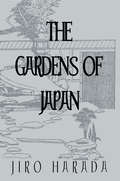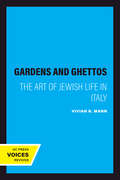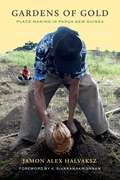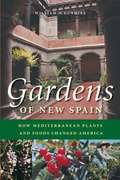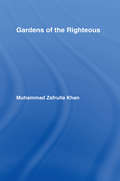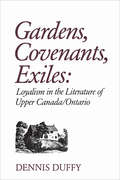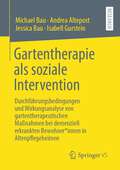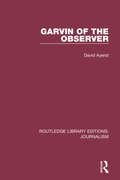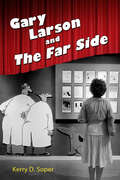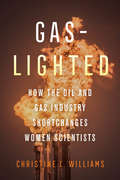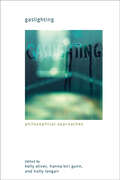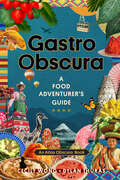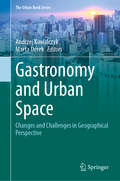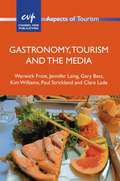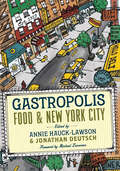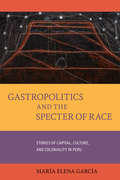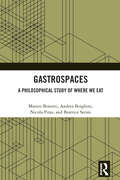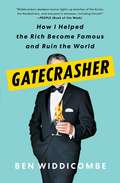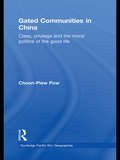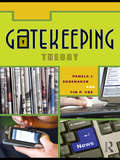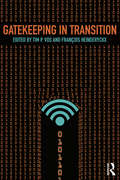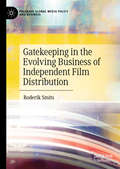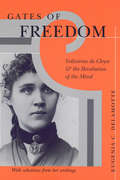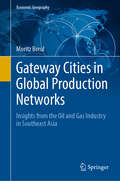- Table View
- List View
Gardens Of Japan
by HaradaFirst published in 2005. Routledge is an imprint of Taylor & Francis, an informa company.
Gardens and Ghettos: The Art of Jewish Life in Italy
by Vivian B. MannThis title is part of UC Press's Voices Revived program, which commemorates University of California Press’s mission to seek out and cultivate the brightest minds and give them voice, reach, and impact. Drawing on a backlist dating to 1893, Voices Revived makes high-quality, peer-reviewed scholarship accessible once again using print-on-demand technology. This title was originally published in 1989.This title is part of UC Press's Voices Revived program, which commemorates University of California Press’s mission to seek out and cultivate the brightest minds and give them voice, reach, and impact. Drawing on a backlist dating to 1893, Voices Revived</DIV
Gardens of Gold: Place-making in Papua New Guinea (Culture, Place, and Nature)
by K. Sivaramakrishnan Jamon Alex HalvakszSince the start of colonial gold mining in the early 1920s, the Biangai villagers of Elauru and Winima in Papua New Guinea have moved away from planting yams and other subsistence foods to instead cultivating coffee and other cash crops and dishing for tradable flakes of gold. Decades of industrial gold mining, land development, conservation efforts, and biological research have wrought transformations in the landscape and entwined traditional Biangai gardening practices with Western capital, disrupting the relationship between place and person and the social reproduction of a community. <P><P> Drawing from extensive ethnographic research, Jamon Halvaksz examines the role of place in informing indigenous relationships with conservation and development. How do Biangai make meaning with the physical world? Collapsing Western distinctions between self and an earthly other, Halvaksz shows us it is a sense of place--grounded in productive relationships between nature and culture--that connects Biangai to one another as "placepersons" and enables them to navigate global forces amid changing local and regional economies. Centering local responses along the frontiers of resource extraction, Gardens of Gold contributes to our understanding of how neoliberal economic practices intervene in place-based economies and identities.
Gardens of New Spain
by William W. DunmireWhen the Spanish began colonizing the Americas in the late fifteenth and sixteenth centuries, they brought with them the plants and foods of their homeland—wheat, melons, grapes, vegetables, and every kind of Mediterranean fruit. Missionaries and colonists introduced these plants to the native peoples of Mexico and the American Southwest, where they became staple crops alongside the corn, beans, and squash that had traditionally sustained the original Americans. This intermingling of Old and New World plants and foods was one of the most significant fusions in the history of international cuisine and gave rise to many of the foods that we so enjoy today. Gardens of New Spain tells the fascinating story of the diffusion of plants, gardens, agriculture, and cuisine from late medieval Spain to the colonial frontier of Hispanic America. Beginning in the Old World, William Dunmire describes how Spain came to adopt plants and their foods from the Fertile Crescent, Asia, and Africa. Crossing the Atlantic, he first examines the agricultural scene of Pre-Columbian Mexico and the Southwest. Then he traces the spread of plants and foods introduced from the Mediterranean to Spain’s settlements in Mexico, New Mexico, Arizona, Texas, and California. In lively prose, Dunmire tells stories of the settlers, missionaries, and natives who blended their growing and eating practices into regional plantways and cuisines that live on today in every corner of America.
Gardens of the Righteous: Riyadh As Salihin Of Imam Nawawi
by Muhammad Zafrulla KhanA collection of Muslim traditions.
Gardens, Covenants, Exiles: Loyalism in the Literature of Upper Canada/Ontario
by Dennis DuffyScraps, tags, figments of the United Empire Loyalist heritage dot the Ontario landscape. Something of Loyalism lies in the very Ontario air and pervades the imagination of its people. In Gardens, Covenants, Exiles, Dennis Duffy sets out to describe and analyse the effects of Loyalism on the literary culture of Ontario. He explores the enduring nature of an attitude of mind whose historical origins lie in the Loyalist settlements in the forests of Upper Canada. No single source can explain a culture's characteristic way of viewing moral, social, and literary matters. This study, however, reveals how one historical event and the mythology it engendered have helped to shape a province and its literature. The collective experience of the Loyalists underlies Ontario's view of the Canadian destiny. Their defeat, exile, endurance, and their final mastery of a new land confirmed their belief that their own destiny lay within a larger imperial framework. But they lived at the same time as both North Americans and monarchists, victims and founders, heroes and the dispossessed. Writers in this culture, faced with the declining importance of the British connection and the rising of American presence, were ill-prepared by their political and imaginative lives to comprehend the vision of an independent nation. In our own time this has led to a renewed sense of fall, to a disillusionment that contrasts sharply with the feeling of 'paradise regained; that pervaded an earlier era. The book is a study of dislocation, seen through vignettes of various authors and their writings: William Kirby's The Golden Dog, Major Richardson's Wacousta, Charles Mair's Tecumseh, and the Jalna series by Mazode la Roche. Contemporary analogues of the Loyalist habit of mind are pursued in the works of George Grant, Dennis Lee, Al Purdy, and Scott Symons: the journey returns to its Loyalist starting point, in pain, loss, and the sense of a vanished home. Loyalism, both as fact and as myth, is one of the cultural forces that has given Ontario its sense of place. Professor Duffy concludes that in some way the culture of Upper Canada/Ontario remains continuous, that it has kept faith with its origins. His study heightens our understanding of a nation's roots.
Gartentherapie als soziale Intervention: Durchführungsbedingungen und Wirkungsanalyse von gartentherapeutischen Maßnahmen bei demenziell erkrankten Bewohner*innen in Altenpflegeheimen
by Andrea Altepost Michael Bau Jessica Bau Isabell GursteinDas ILAG – Institut Leistung Arbeit Gesundheit ist ein interdisziplinär arbeitendes sozialwissenschaftliches Forschungsinstitut und führt seit 2007 Untersuchungen zu Fragen der Gesundheit und zur Veränderung von Arbeit im demografischen und digitalen Wandel durch.
Garvin of the Observer (Routledge Library Editions: Journalism #1)
by David AyerstOriginally published in 1985. One of the most distinguished editors in the history of British journalism, J. L. Garvin created the Sunday newspaper as we now know it. His career at the Observer spanned the golden age of the British press when newspapers had a powerful influence on political affairs. Like the other great editors of the first half of the twentieth century Garvin clashed with his proprietors. He liked to contrast ‘Responsible Editorship’ with ‘Austensible Editorship’ where the editor took his political orders from the owners. He passionately believed that the readers of any newspaper worth buying had a right to know what the editor himself thought about any important matter. This was the essence of an implied contract, the basis of trust between paper and the reader. It was Garvin’s energy and integrity which transformed the Observer into a major force in the British press so that long before his death most respectable middle class families would have hesitated to admit they had not seen the Observer. This first substantial biography of Garvin of the Observer will be of interest to all students of modern political history and of the press in contemporary society.
Gary Larson and The Far Side (Great Comics Artists Series)
by Kerry D. SoperKerry D. Soper reminds us of The Far Side's groundbreaking qualities and cultural significance in Gary Larson and "The Far Side." In the 1980s, Gary Larson (b. 1950) shook up a staid comics page by introducing a set of aesthetic devices, comedic tones, and philosophical frames that challenged and delighted many readers, even while upsetting and confusing others. His irreverent, single panels served as an alternative reality to the tame comedy of the family-friendly newspaper comics page, as well as the pervasive, button-down consumerism and conformity of the Reagan era.In this first full study of Larson's art, Soper follows the arc of the cartoonist's life and career, describing the aesthetic and comedic qualities of his work, probing the business side of his success, and exploring how The Far Side brand as a whole--with its iconic characters and accompanying set of comedic and philosophical frames--connected with its core readers. In effect, Larson reinvented his medium by creatively working within, pushing against, and often breaking past institutional, aesthetic, comedic, and philosophical parameters.Due to the comic's great success, it opened the door for additional alternative voices in comics and other popular mediums. With its intentionally awkward, minimalistic lines and its morbid humor, The Far Side expanded Americans' comedic palette and inspired up-and-coming cartoonists, comedians, and filmmakers. Soper re-creates the cultural climate and media landscape in which The Far Side first appeared and thrived, then assesses how it impacted worldviews and shaped the comedic sensibilities of a generation of cartoonists, comedy writers, and everyday fans.
Gary Null's Power Aging
by Gary NullPart I explains how our modern environment, as well as our own biological processes, contribute to aging. Part II looks at hormonal keys to health, and shows how they can address specific concerns- from maintaining cardiovascular function, facing the specter of cancer, and staying mentally sharp. Part III puts it all together in a practical way, including a new diet and exercise program. Book Info The book outlines a plan for reversing, eliminating, and controlling the signs of aging. Based on sensible science and mind-over-matter techniques and discusses the biological processes of aging, hormones affecting the aging process, and how to stay mentally sharp. It also provides healthy recipes.
Gaslighted: How the Oil and Gas Industry Shortchanges Women Scientists
by Christine L. WilliamsThe oil and gas industry is one of the richest and most powerful industries in the world. In recent years, company avowals in support of diversity, much-touted programs for "women in STEM," and, most importantly, a tight labor market with near parity in women pursuing geoscience credentials might lead us to expect progress for women in this industry's corporate ranks. Yet, for all the talk of "the great crew change," the industry remains overwhelmingly white and male. Sociologist Christine L. Williams asks, where are the women? To answer this question, Williams embarked on a decade-long investigation—one involving one hundred in-depth interviews, a longitudinal survey, and ethnographic research—that allowed her to observe the industry in times of boom and bust. She found that when the industry expands, women may be able to walk through the door, but when the industry contracts, the door becomes a revolving one, whirling ever faster, as companies retreat to their white male core. These gendered outcomes are obscured by firms' stated commitments to diversity in hiring and the language of merit. The result is organizational gaslighting, a radical dissonance between language and practice that Williams exposes for all.
Gaslighting: Philosophical Approaches (SUNY series in Gender Theory)
by Kelly Oliver Hanna Kiri Gunn Holly LongairA feminist introduction to emerging philosophical understandings of gaslighting.Originating in a 1938 play, the term gaslighting has become part of our everyday vocabulary. But do we truly know what it means? This collection of new and foundational essays explores concepts and experiences of gaslighting from philosophical perspectives. Contributors build on longstanding feminist analyses of the relations among knowledge, affect, and power to consider how gaslighting can work at not only individual but also structural levels to undermine its targets. In examining racial, epistemological, medical, affective, political, and other forms of gaslighting, the book helps illuminate contemporary power relations and provides urgently needed tools for further research in and beyond the field of philosophy.
Gastro Obscura: A Food Adventurer's Guide (Atlas Obscura)
by Cecily Wong Dylan Thuras Atlas ObscuraTaste the World! It&’s truly a feast of wonder: Created by the ever-curious minds behind Atlas Obscura, this breathtaking guide transforms our sense of what people around the world eat and drink. Covering all seven continents, Gastro Obscura serves up a loaded plate of incredible ingredients, food adventures, and edible wonders. Ready for a beer made from fog in Chile? Sardinia&’s &“Threads of God&” pasta? Egypt&’s 2000-year-old egg ovens? But far more than a menu of curious minds delicacies and unexpected dishes, Gastro Obscura reveals food&’s central place in our lives as well as our bellies, touching on history–trace the network of ancient Roman fish sauce factories. Culture–picture four million women gathering to make rice pudding. Travel–scale China&’s sacred Mount Hua to reach a tea house. Festivals–feed wild macaques pyramid of fruit at Thailand&’s Monkey Buffet Festival. And hidden gems that might be right around the corner, like the vending machine in Texas dispensing full sized pecan pies. Dig in and feed your sense of wonder. &“Like a great tapas meal, Gastro Obscura is deep yet snackable, and full of surprises. This is the book for anyone interested in eating, adventure and the human condition.&” –Tom Colicchio, chef and activist &“This exquisite guide kept me at the breakfast table until dinner time.&” –Kyle Maclachlan, actor and vintner
Gastronomy and Urban Space: Changes and Challenges in Geographical Perspective (The Urban Book Series)
by Andrzej Kowalczyk Marta DerekThis book focuses on the relationship between gastronomy and urban space. It highlights the intrinsic role of eating establishments and the gastronomy industry for cities by assessing their huge impacts on urban changes and discussing some of the challenges posed by new developments.Written by authors with a background in geography, it starts by discussing theoretical aspects of studies on gastronomy in urban space to place the subject in the broader context of urban geography. Covering both changes and challenges in gastronomy in urban space, it presents a wide range of problems, which are described and analysed using various case studies from Europe and other parts of the world.
Gastronomy, Tourism and the Media
by Warwick Frost Jennifer LaingThis book examines and analyses the connections between gastronomy, tourism and the media. It argues that in the modern world, gastronomy is increasingly a major component and driver of tourism and that destinations are using their cuisines and food cultures in marketing to increase their competitive advantage. It proposes that these processes are interconnected with film, television, print and social media. The book emphasises the notion of gastronomy as a dynamic concept, in particular how it has recently become more widely used and understood throughout the world. The volume introduces core concepts and delves more deeply into current trends in gastronomy, the forces which shape them and their implications for tourism. The book is multidisciplinary and will appeal to researchers in the fields of gastronomy, hospitality, tourism and media studies.
Gastropolis: Food & New York City (Arts and Traditions of the Table Perspectives on Culinary History)
by Hauck-Lawson, Annie S., and Jonathan Deutsch, eds. Foreword by Michael LomonacoThis irresistible sampling of NYC&’s rich food heritage takes readers on a cultural and historical journey from Brooklyn to the Bronx and beyond. Whether you're digging into a slice of cherry cheesecake, burning your tongue on a piece of Jamaican jerk chicken, or slurping the broth from a juicy soup dumpling, eating in New York City is a culinary adventure unlike any other in the world.Gastropolis explores the historical, cultural, and personal relationship between New Yorkers and the food they eat. Beginning with the origins of local favorites, such as Mt. Olympus bagels and Puerto Rican lasagna, the book looks back to early farming practices and the pre-European fare of the Leni Lenape. Essays trace the function of place and memory in Asian cuisine, the rise of Jewish food icons, the evolution of food enterprises in Harlem, the relationship between restaurant dining and identity, and the role of peddlers and markets in guiding the ingredients of our meals. Touching on everything from religion to nutrition; agriculture to economics; and politics to psychology, Gastropolis tells a multifaceted story of immigration, amalgamation, and the making of New York&’s distinctively delicious flavor
Gastropolitics and the Specter of Race: Stories of Capital, Culture, and Coloniality in Peru (California Studies in Food and Culture #76)
by María Elena GarcíaIn recent years, Peru has transformed from a war-torn country to a global high-end culinary destination. Connecting chefs, state agencies, global capital, and Indigenous producers, this "gastronomic revolution" makes powerful claims: food unites Peruvians, dissolves racial antagonisms, and fuels development. Gastropolitics and the Specter of Race critically evaluates these claims and tracks the emergence of Peruvian gastropolitics, a biopolitical and aesthetic set of practices that reinscribe dominant racial and gendered orders. Through critical readings of high-end menus and ethnographic analysis of culinary festivals, guinea pig production, and national-branding campaigns, this work explores the intersections of race, species, and capital to reveal links between gastronomy and violence in Peru.
Gastrospaces: A Philosophical Study of Where We Eat (Critical Food Studies)
by Matteo Bonotti Andrea Borghini Nicola Piras Beatrice SeriniThis book explores the moral and political significance of gastrospaces: the spaces where we eat. It adopts an innovative approach, combining analytic political philosophy and analytic ontology, to lay down the theoretical foundations for a multi- and interdisciplinary research agenda on the complex interconnections between food and space.Social science and humanities scholars have studied the ties between food consumption and space from multiple angles. This book sets up a different and more foundational approach, which engages with these bodies of work and integrates them into a coherent framework. While taking the reader through a theoretical journey of varying complexities, the book also illustrates the social, political, and cultural significance of gastrospaces by surveying an array of examples from diverse historical and geographical contexts. It then draws on political philosophy to show that gastrospaces are sites of justice and injustice and complements this analysis by developing an ontological model for gastrospaces that facilitates a systematic analysis of their social, political, and cultural significance. The book ends with a toolbox for the study of gastrospaces that different stakeholders may apply to their respective contexts of intervention.This book will appeal to philosophers, political scientists, food scholars, geographers, and anyone interested in the intersection between food and space. By focusing on a wide range of real-world topics related to gastrospaces, such as racist dress codes, family-friendly restaurants, speakeasies, and gendered kitchen designs, the book will also be of interest to nonacademic stakeholders such as urban planners, policymakers, designers, managers, and consumers.
Gatecrasher: How I Helped the Rich Become Famous and Ruin the World
by Ben WiddicombeA smart, gossipy, and very funny examination of celebrity culture from New York&’s premiere social columnist. Ben Widdicombe is the only writer to have worked for Page Six, TMZ, and The New York Times—an unusual Triple Crown that allowed him personal access to the full gamut of Hollywood and high society&’s rich and famous, from billionaires like Rupert Murdoch, Donald Trump, and the Koch brothers, to pop culture icons Kim Kardashian and Paris Hilton. Now, in Gatecrasher, New York&’s premiere gossip-turned-society writer spills the sensational stories that never made it to print. Widdicombe has appeared at nearly every gossip-worthy venue—from the Oscars and the Hamptons, to the Met Gala and Mar-a-Lago—and has rubbed elbows with a dizzying array of celebrities (and wannabes), and he whisks us past the clipboard and velvet rope to teach us the golden rules of gatecrashing, dishing on dozens of boldface names along the way. Widdicombe shares secrets for how to crash the parties, climb the ladder, avoid the paparazzi, or make small talk with Henry Kissinger and Anna Wintour. Endlessly fun and extremely telling, Gatecrasher makes the unnerving argument that Paris Hilton conquering pop culture two decades ago lead to Donald Trump winning the White House. &“As the gossip pages go, so goes the country,&” he says.
Gated Communities in China: Class, Privilege and the Moral Politics of the Good Life (Routledge Pacific Rim Geographies)
by Choon-Piew PowMoving beyond conventional accounts of gated communities and housing segregation, this book interrogates the moral politics of urban place-making in China’s commodity housing enclaves. Drawing on fieldwork and survey conducted in Shanghai, Pow critically demonstrates how gated communities are bound up in the cultural reproduction of middle-class landscape that is entrenched in the politics of the good life – defined in terms of a highly segregated landscape secured and maintained through the territorialisation of privilege, lifestyle and private property. The study challenges the concept of gated communities as simply ‘spatial containers’ of social classes and argues that Shanghai’s gated enclaves may be more fruitfully analyzed as critical sites of and for the production and consumption of an exclusive lifestyle where nascent middle-class sensibilities and identities are being (re)presented, cultivated and lived. In the final analysis, the book addresses an overarching normative concern by examining how social-spatial differentiation and exclusion in Shanghai’s gated communities potentially disrupt, challenge and unsettle the modern ideals of urban life. By adopting a geographical moral perspective, this book illuminates the moral complexities and ambiguities of place-making in Shanghai’s increasingly polarized urban landscape. As the first book length academic study on gated communities in China, this book will appeal broadly to those with interests in Urban studies and urban social development in China.
Gatekeeping Theory
by Pamela J. Shoemaker Timothy VosGatekeeping is one of the media’s central roles in public life: people rely on mediators to transform information about billions of events into a manageable number of media messages. This process determines not only which information is selected, but also what the content and nature of messages, such as news, will be. Gatekeeping Theory describes the powerful process through which events are covered by the mass media, explaining how and why certain information either passes through gates or is closed off from media attention. This book is essential for understanding how even single, seemingly trivial gatekeeping decisions can come together to shape an audience’s view of the world, and illustrates what is at stake in the process.
Gatekeeping in Transition
by Tim P. Vos François HeinderyckxFirst published in 2014. Routledge is an imprint of Taylor & Francis, an informa company.
Gatekeeping in the Evolving Business of Independent Film Distribution (Palgrave Global Media Policy and Business)
by Roderik SmitsThis book is about the business of distribution, around which the international film business revolves. Considering sales agents and distributors as primary gatekeepers, the book examines the networks in which they operate, how they operate, how their practices have evolved, and the power and control they exert over the business of independent film distribution. Critically, it also considers how they are affected by the powerful influence of Netflix and Amazon in the online era. At a time of disruption and change to traditional business models and industry professions, Roderik Smits argues that gatekeepers remain equally – if not more – crucial to the distribution and circulation of films in international markets.
Gates of Freedom: Voltairine de Cleyre and the Revolution of the Mind
by Eugenia C. DelamotteDe Cleyre (1866-1912) was one of the late-19th-century American freethinkers, anarchists and sex radicals who are excluded not only from the canon in general, but even from the most progressive textbook anthologies. Delamotte (English, Arizona State U. ) puts into context her thoughts on freeing thought, fated fruit, sex slavery, and refashioning the mind. Then she offers a selection from the hundreds of poems, sketches, essays, lectures, pamphlets, translations, and short stories she penned during her short life. Only names are indexed. Annotation ©2004 Book News, Inc. , Portland, OR (booknews. com)
Gateway Cities in Global Production Networks: Insights from the Oil and Gas Industry in Southeast Asia (Economic Geography)
by Moritz BreulThis book provides a comprehensive analysis of the role of gateway cities in contemporary circuits of global production. Apart from facilitating the interlinking of economic activities in the surrounding regions with the global economy, gateway cities have enormous implications for how certain regions participate in the global economy. Based on a case study of the oil and gas industry in Southeast Asia the book maps gateway cities, explores why these cities have come to occupy a gateway role, and evaluates their implications for regional economic development. To this aim, the book links components from research on the World City Network with Global Production Network research and demonstrates how this intersection creates synergies for studying the role of cities in economic globalization. The main audiences that this book appeals to are researchers and students interested in debates on regional development and the role of cities in the global economy. The book is also attractive to scholars interested in the organization of extractive industries.
